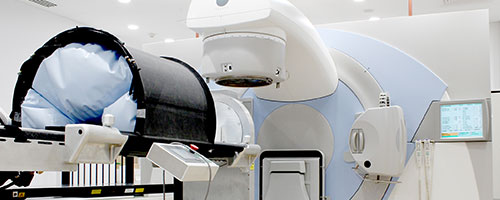Novel Radiation Therapy Systems and Applications
-

Nano-X
What if … precision cancer radiation therapy didn’t have to cost so much? Radiotherapy is the recommended treatment for about half of all cancer patients. Less than one third actually receive it, meaning that millions of people around the world miss out – every year. There is a massive global demand for affordable radiotherapy machines.…
Medical Imaging Research Projects
-

SpinePrint Laboratory Project
3D-printed surgical solutions. The SpinePrint Laboratory Project is founded by Dr Tess Reynolds, working in close collaboration with orthopaedic surgeon Dr Andrew Kanawati (Westmead Hospital). It is dedicated to delivering novel 3D-printed solutions to the treatment of disease, currently focused on applications in oncology and orthopaedics. Surgical Guides Accurate drilling and cutting are fundamental to…
-

Interventional Imaging Program
Image X Interventional Imaging is an international academic-industry-healthcare program led by Dr Tess Reynolds. It is dedicated to delivering innovative robotic imaging and novel 3D-printed solutions to aid in the diagnosis and treatment of disease spanning cardiology, neurology, oncology, radiology, and orthopaedics. Project highlights Extending the intraoperative field-of-view Intraoperative 3D Cone Beam CT (CBCT) imaging…
-

Improved 4D CBCT image acquisition
The problem to be solved Lung cancer is the leading cause of cancer death worldwide. Better targeted radiotherapy will improve treatment outcomes: a 1-Gy increase in tumour dose results in a 4% improvement in survival and a 1-Gy decrease in lung dose results in a 2% reduction in pneumonitis. To achieve tumour dose increase and…
-

Respiratory Adaptive Computed Tomography (REACT)
Clearer lung cancer images, on standard CT Imagers. Current Results Milestones Intellectual property Keall, P.J. and J.F. Williamson, Method and system of adaptive control for reducing motion artifacts and patient dose in four dimensional computed tomography. 2013 Publications N. Morton, P. Keall, R. O’Brien and T. Reynolds, “CArdiac and REspiratory adaptive Computed Tomography (CARE-CT): a proof-of-concept…
-

ACROBEAT
Safer, Faster, Clearer Imaging. What if we adapted the imaging equipment to the moving patient, rather than making the patient conform to the limitations of the equipment? Acquiring images only when the heart and lungs are in perfect position would result in clearer images, and no unnecessary radiation dose to the patient. We’re creating imaging…
-

CT Ventilation Imaging
CT Ventilation Imaging is software that shows us how well different areas of the lung are performing. This means we can make sure we protect the healthy areas during radiation therapy. Cancer and lung function. For people with lung cancer, there are numerous factors other than the cancer itself which can seriously impact on the…
-

The Patient Connected Imaging Program
By connecting the patient’s physiological signals to imaging acquisition, we can ensure clearer images, lower imaging dose and faster acquisition. The Patient Connected Imaging Program is a suite of projects which use the patient’s respiratory or cardiac signals to improve the images we can achieve across different imaging techniques. REACT Clearer lung cancer images, on…
-

SPARE Challenge
The Sparse-view Reconstruction Challenge for Four-dimensional Cone-beam CT – 2018 The aim of this challenge was to systematically investigate the efficacy of various algorithms for 4D CBCT reconstruction from a one minute scan. Rationale The goal of the SPARE challenge was to explore the possibility of high quality 4D CBCT while sparing patients the additional…
Cancer Targeting Research Projects
-

Cardiac Radioablation Program
Reducing the impact of radiation on the heart for cancer and cardiac disease patients The Cardiac Radioablation program is funded by an NHMRC Synergy Grant. Background Ventricular tachycardia (VT) and atrial fibrillation (AT) are cardiac conditions that affect over 33.5 million people globally every year. Treatment typically involves invasive heart surgery to manually create scar…
-

AV Biofeedback
AV biofeedback is a simple, personalised and interactive respiratory guide designed to facilitate regular patient breathing. The AV biofeedback system is shown in figure 1. Figure 1. AV biofeedback system. Display screen and marker block on the abdomen shown. The visual display (centre) as seen by the subject (sans arrows) of the AV biofeedback system…
-

Kilovoltage Intrafraction Monitoring (KIM)
Real-time cancer targeting on a standard linear accelerator. The Problem Our solution How KIM works Intellectual Property Three granted US patents Research Opportunities For more information and enquiries contact Professor Paul Keall. [email protected]
-

Beam Adaptation
Compatible with 95% of existing radiotherapy systems, Beam Adaptation is an affordable technology that has the potential to improve the outcomes for millions of cancer patients globally. Cancer Is a Moving Target. Even when a patient is lying perfectly still, there are dynamic processes happening inside the body. The heart is beating and the lungs…
-

Markerless Tracking
The Problem Due to a patient’s breathing, lung tumours are constantly moving. Current radiotherapy treatments allow for this movement by treating with a large radiation beam, to try and ensure they cover the entire tumour. This means that healthy tissue often gets hit with radiation and can sometimes even miss the tumour. For lung cancer…
-

Remove the Mask
Reducing anxiety and distress for head and neck cancer patients. Remove the Mask is a patient-led project forged by Julie McCrossin OAM and Professor Paul Keall, to improve treatment for Head and Neck Cancer (HNC) patients. The project’s first steps were enabled by a successful public crowdfunding campaign in 2018. This funding provided Remove the…
Quality Assurance Research Projects
-

Robotic QA Phantom – 6DoF
The robotic phantom quality assurance device accurately mimics tumour motion, ensuring safe implementation of radiotherapy technologies in the clinic.